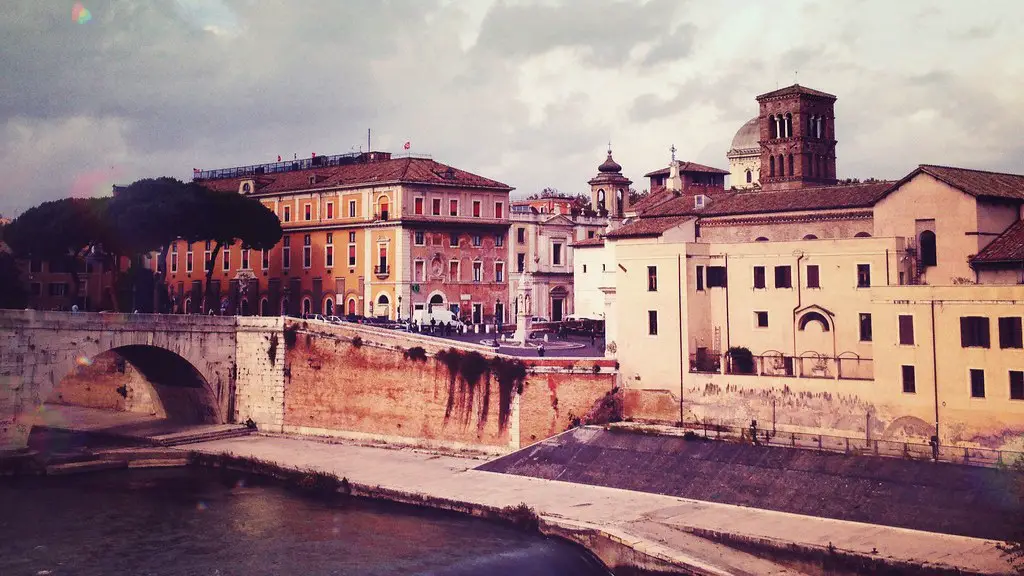Background
The first Roman road built in ancient Rome was the Via Appia, or Appian Way. It was constructed by Appius Claudius Caecus in 312 BC, and it was one of the earliest and most important roads in the Roman Republic. The Roman roads had a massive impact on the economy and militarization of the Roman Empire, as they made communication and transportation between widely dispersed areas a lot more efficient. The Appian Way was the longest and most important road, and it spanned over 500 miles from Rome to Brindisi, a port city on the Adriatic Sea.
Construction
The Latin word via means “way” and it is the source of the modern word for a roadway, “road.” The Via Appia was one of the earliest roads constructed in the Roman Republic, and it was similar in design to other ancient Roman roads. It was built from layers of hardened dirt and stones, some of which were excavated from the surrounding area. It was also built across existing terrain and hills and it was slightly sloped in order to facilitate drainage. The Appian Way was 4-6 meters wide, which was quite large for the time. At certain points, the road was expanded to accommodate larger military vehicles and carriages.
Connecting Cities
The Via Appia was divided into sections, and each section was represented by a milestone which was constantly monitored by army engineers. The Via Appia connected various towns along its route, and these towns usually had a nearby military camp. This allowed the Roman Army to keep track of its troops and to quickly deploy them to various locations. Not only did the Appian Way help facilitate military operations, it also made trade and communication between far away cities much easier.
Significance
The Appian Way was a marvel of engineering and helped the Roman Republic to expand its influence across the Mediterranean world. It was a symbol of the Roman Republic’s power and helped to create stability across its territories. The Appian Way was also sculpted with reliefs and inscriptions, which were reminders to travelers of the greatness of Rome. The Appian Way was also a major trade route, and goods such as pottery, textiles, and wine were transported along its length.
Maintenance and Rehabilitation
The Roman Republic maintained the Appian Way throughout its existence, and it was regularly patrolled by army engineers. At certain points, the Appian Way was widened and gravel was added to help improve the road’s quality. The Romans also had a system of rest stops called “mansios” which were located along the road and allowed travelers to find food and lodging. In later years, the Appian Way was used by invading forces, and it was eventually destroyed by the Visigoths in 410AD.
Preservation
In recent centuries, the Appian Way has been largely forgotten. Much of the original road has deteriorated or been destroyed, but some sections have been preserved. In the 19th century, a French archaeologist named Charles de Broglie began an excavation of the Appian Way and documented many of its features. This project spurred a massive preservation effort that continues to this day. A modern preservation agency, the “Friends of the Appian Way” is working to protect and restore the remaining portions of the original road.
Influence
The Appian Way has a long and storied history and is one of the most important roads in the Roman Republic. It served as an important communication link between Rome and its vast network of cities, and it was a symbol of the Republic’s power and influence. The Appian Way has also inspired numerous other roads around the world, including the American Appian Way, a vast highway across the United States of America.
Relevance in the Modern World
Today, the Appian Way is still an important part of Italy’s cultural heritage. The original road is largely in ruins, but it still serves as an important reminder of the timelessness of human achievement. It is also popular among tourists and history buffs, and it is one of Italy’s most visited sights. As the Appian Way is restored, the legacy of Rome will continue to be celebrated and remembered.
Impact on Rome
The Appian Way had a major impact on Rome’s prosperity and status in the ancient world. Its construction allowed the Republic to quickly transport goods and soldiers across its vast network of cities. It established trade between these cities, which boosted their economies and helped them to develop. The Appian Way also helped to extend and consolidate Roman rule, and it allowed Rome to create a network of provinces that it controlled.
Impact on Beliefs
The Appian Way was a symbol of the Rome’s power, and it was celebrated and celebrated by the people. Not only did it help to expand and strengthen their empire, it also inspired them with a sense of pride and patriotism. The Appian Way was also celebrated in literature, and it was often portrayed as a symbol of Rome’s greatness. It was also a source of inspiration for philosophy and religious beliefs, and its influence can still be seen in modern cultures.
Enduring Legacy
The Appian Way is an enduring reminder of Rome’s great accomplishments and its lasting influence on the world. Its construction was an important milestone in history, and it had a major impact on the people and cultures of the time. Its legacy is still celebrated today, and it is still recognized as a symbol of Rome’s greatness and its lasting influence on the world. It stands as a testament to the power of human achievement and its timelessness.


